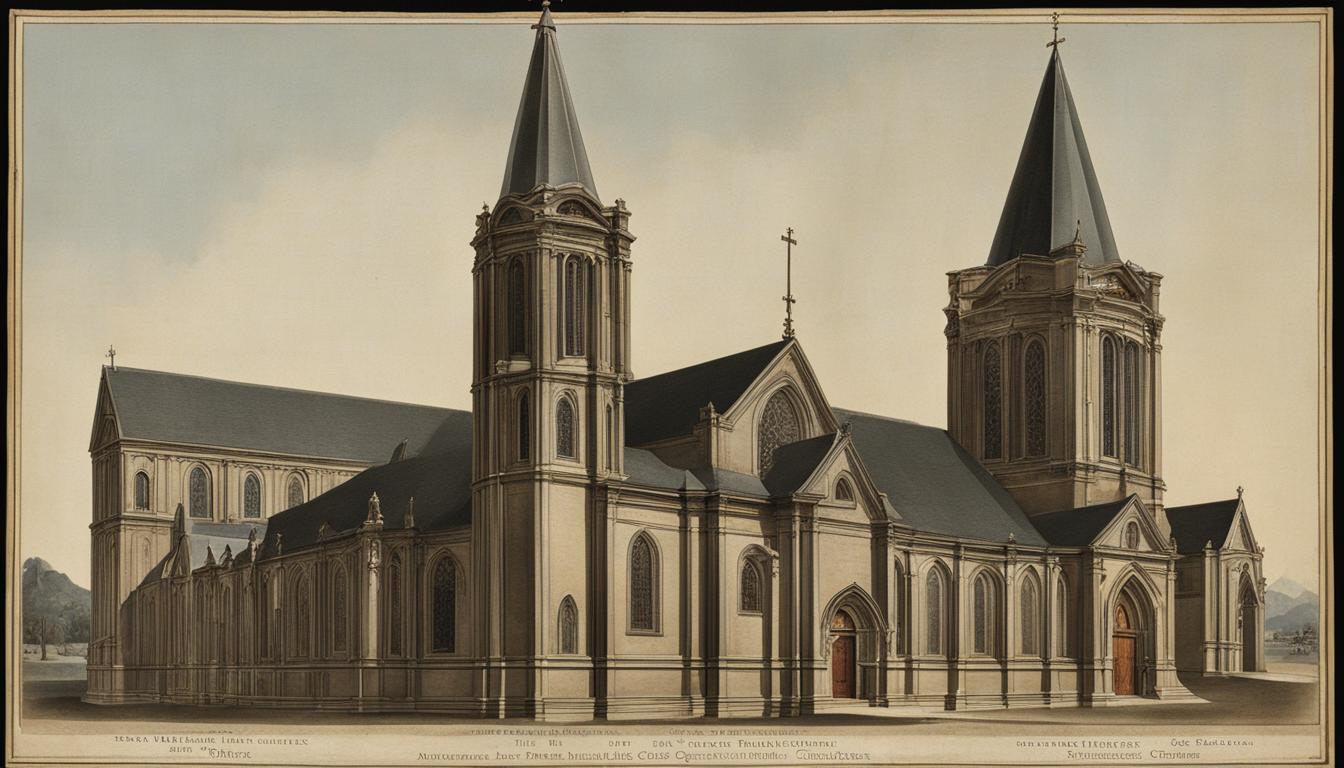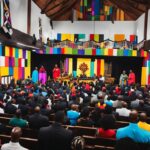In recent years, church design trends have undergone a notable transformation. Churches are now embracing innovative ideas to appeal to younger generations and create more community-oriented spaces. This article will delve into the modern upgrades and trends in church design and construction that are shaping the future of ecclesiastical architecture in the United States.
Key Takeaways:
- Innovations in church design and construction are revolutionizing the way churches cater to their congregations.
- Churches are embracing mixed-use developments to attract more people and boost revenue.
- Alternative solutions like food trucks and catering businesses are being incorporated instead of building large commercial kitchens.
- Flexible seating arrangements, such as stackable chairs, are replacing traditional pews for versatility.
- Digital media and smart technology are being utilized to enhance the church experience and automate tasks.
Embracing Mixed-Use Developments
Many churches are recognizing the benefits of embracing mixed-use developments as a way to enhance their church campuses and increase revenue. By locating the church in well-trafficked areas that also feature other businesses, churches can attract more people and create a vibrant community hub.
One of the key advantages of mixed-use developments is the increased visibility that comes with being in a bustling area. This visibility not only helps churches draw in new visitors but also allows them to showcase their presence and engage with the surrounding community. Additionally, sharing a space with other businesses can provide opportunities for collaboration and partnerships, further expanding the church’s reach.
Moreover, the financial benefits of mixed-use developments should not be overlooked. By generating additional revenue through renting out space to businesses or residential units, churches can fund various outreach programs, facility maintenance, and other important initiatives. This boost in revenue allows churches to invest in their community and continue serving their congregation effectively.
The Benefits of Embracing Mixed-Use Developments:
- Increased visibility and community engagement
- Opportunities for collaboration and partnerships
- Boost in revenue to support church programs and initiatives
In conclusion, embracing mixed-use developments presents churches with a way to create thriving community-oriented spaces and generate additional revenue. By strategically choosing locations and fostering partnerships with businesses, churches can ensure their long-term sustainability while making a positive impact on the neighborhoods they serve.
| Benefits of Embracing Mixed-Use Developments |
|---|
| Increased visibility and community engagement |
| Opportunities for collaboration and partnerships |
| Boost in revenue to support church programs and initiatives |
“By locating the church in well-trafficked areas with other businesses, churches can attract more people and experience the benefits of increased visibility and revenue.”
Rethinking Commercial Kitchens
When it comes to church design and construction, traditional commercial kitchens are no longer the only option. Churches are now embracing alternative solutions such as food trucks, coffee carts, and hiring catering businesses to meet their culinary needs. This shift not only saves valuable space but also reduces operational costs and provides flexibility for different events and gatherings.
By incorporating food trucks and coffee carts into their church campuses, churches can create a unique and engaging experience for their congregation. These mobile food options allow for easy customization of menus and can be positioned in different locations depending on the event or gathering. Additionally, partnering with local catering businesses not only supports the community but also allows for a variety of culinary offerings without the need for a large commercial kitchen on-site.
The decision to rethink commercial kitchens in churches is driven by practicality and the desire to create more dynamic and versatile spaces. With the ability to easily remove or reconfigure food trucks, coffee carts, or catering setups, churches can transform their spaces to accommodate a range of activities beyond traditional meals, such as workshops, fundraisers, or even outdoor worship services. This flexibility caters to the evolving needs of modern congregations and promotes a sense of community and connection within the church.
Incorporating Alternative Culinary Solutions
- Food trucks and coffee carts offer customizable menus and mobility for different events
- Hiring catering businesses supports the local community and provides a variety of culinary options
- Removing the need for a large commercial kitchen saves space and reduces costs
- Flexibility to transform spaces for various activities beyond traditional meals
- Promoting community and connection within the church through shared culinary experiences

Table: Pros and Cons of Rethinking Commercial Kitchens
| Pros | Cons | |
|---|---|---|
| Space | Saves valuable space | Limited storage for ingredients |
| Cost | Reduces operational costs | Potential reliance on external vendors |
| Flexibility | Allows for easy customization and mobility | Dependent on availability of food trucks and catering businesses |
| Community | Supports local businesses and creates culinary partnerships | Loss of control over menu and food quality |
Flexible Seating Arrangements
As churches reimagine their design and strive to create more inclusive and versatile spaces, flexible seating arrangements have emerged as a popular trend. Traditional church pews are being replaced with more practical seating options, such as stackable chairs, to accommodate a variety of uses and events. This shift towards flexibility not only allows for easy reconfiguration of the seating layout but also promotes a minimalist aesthetic.
By embracing flexible seating, churches can easily adapt their worship spaces to cater to different purposes, such as banquets, concerts, weddings, or even sports games. The ability to quickly rearrange or remove seating provides a dynamic atmosphere, ensuring that the space can be transformed to meet the needs of the congregation and the surrounding community. Moreover, stackable chairs allow for efficient use of space when not in use, offering churches the flexibility to utilize the area for other activities.
This move towards flexible seating aligns with the growing trend of churches embracing a minimalist aesthetic. The clean lines and uncluttered look of stackable chairs create a modern and inviting atmosphere. The simplicity of the seating design allows the focus to shift towards the worship experience, fostering a sense of connection and community among the congregation.
Benefits of Flexible Seating Arrangements:
- Adaptability to cater to different events and purposes
- Efficient use of space and storage
- Promotion of a minimalist aesthetic
- Enhanced worship experience and sense of community
By embracing flexible seating arrangements and the minimalist aesthetic, churches can create versatile and welcoming spaces that cater to the needs of their congregation and the broader community.
Incorporating Digital Media and Smart Technology
The modernization of churches extends beyond physical spaces; it also encompasses the integration of digital media and smart technology. Churches have recognized the power of digital platforms and are utilizing them for various purposes, including social media marketing, content creation, and announcements during services.
With the rise of digital media production, churches can now create engaging and compelling content that resonates with their congregation and reaches a wider audience. From professionally produced videos to live streaming services, these digital media initiatives provide opportunities for people to connect with their faith in new and innovative ways.
Moreover, the incorporation of smart technology has revolutionized the way churches operate. Automation systems streamline administrative tasks, allowing staff members to focus on more meaningful aspects of their work. Security systems ensure the safety of church facilities and worshippers, providing peace of mind.
“The integration of digital media and smart technology in churches has enhanced the overall worship experience for congregations. It allows us to engage with our community on a deeper level and reach new audiences,” says Reverend James Anderson of Lakeview Community Church.
Incorporating Digital Media
The use of digital media in churches goes beyond just marketing and announcements. It also serves as a powerful tool for inspiring and connecting with congregants. Through professionally produced videos, churches can share testimonies, sermons, and other faith-based content that uplifts and encourages their members. Additionally, social media platforms provide avenues for ongoing engagement and community-building.
Smart Technology for Efficiency
The integration of smart technology allows churches to optimize their operations and resources. Automation systems can control lighting, sound, and other technical aspects, ensuring a seamless worship experience. Furthermore, security systems with advanced features such as video surveillance and access control provide a safe and secure environment for worshippers.
| Benefits of Incorporating Digital Media and Smart Technology in Churches |
|---|
| Enhanced worship experience through engaging content |
| Increased reach and connection with the congregation |
| Streamlined administrative tasks and improved efficiency |
| Enhanced security measures for the safety of worshippers |
Bringing the Outdoors Indoors
One of the exciting trends in modern church design is the incorporation of indoor-outdoor spaces. Churches are now creating a seamless connection between the interior and exterior by installing floor-to-ceiling glass sliding doors. These innovative architectural features bring in ample natural light and allow congregants to enjoy the beauty of the surrounding environment while still being sheltered within the church walls.

By embracing indoor-outdoor spaces, churches are able to create a sense of openness and expansiveness. The abundance of natural light not only creates a warm and inviting atmosphere but also provides a visual connection to the world outside. This connection to nature can enhance the spiritual experience of worshipers and foster a deeper sense of awe and reverence.
Furthermore, indoor-outdoor spaces offer practical advantages as well. They can serve as versatile gathering areas for community events, weddings, or other social activities. The seamless transition between indoor and outdoor spaces allows for a larger capacity and encourages congregants to engage with one another and enjoy the surrounding environment.
Benefits of Indoor-Outdoor Spaces:
- Natural light creates a warm and inviting atmosphere
- Visual connection to the outdoors enhances the spiritual experience
- Versatile gathering areas for community events
- Seamless transition between indoor and outdoor spaces
- Encourages congregational engagement and connection
The incorporation of floor-to-ceiling glass sliding doors in church design is a testament to the innovative thinking and desire to create spaces that are both functional and inspiring. These indoor-outdoor spaces not only enrich the worship experience but also serve as a reminder of the beauty and wonder of God’s creation.
Creating Community-Oriented Workspaces
Churches are embracing community-oriented workspaces to foster collaboration, creativity, and a welcoming culture. These flexible work environments promote a sense of community within the church and provide a space for staff members to work on-site, strengthening the connection between the church and its congregation.
By creating workspaces that encourage interaction and collaboration, churches are able to build stronger relationships with their members. These spaces are designed to be flexible, allowing for different work styles and tasks. They may include shared desks, lounge areas, and meeting rooms, providing various options for individuals to work or collaborate in a way that suits their needs.
With community-oriented workspaces, churches can also attract volunteers who are looking for opportunities to serve their community. These work environments provide a sense of purpose and belonging, allowing volunteers to contribute to the church’s mission in a meaningful way.

Benefits of Community-Oriented Workspaces:
- Promotes collaboration and creativity
- Strengthens the connection between the church and its congregation
- Attracts volunteers who are looking for opportunities to serve
- Fosters a sense of community and belonging
- Provides flexibility for different work styles and tasks
“A community-oriented workspace allows us to work together, share ideas, and create a welcoming environment for our congregation and volunteers.” – Pastor John Smith
In conclusion, community-oriented workspaces in churches have become a hallmark of modern church design and construction. By creating flexible work environments that promote collaboration and foster a sense of community, churches can strengthen their relationships with members and attract volunteers who are passionate about serving. These workspaces contribute to a welcoming culture and provide the necessary infrastructure for the church’s mission to thrive.
Embracing “Empty Space”
When it comes to modern church design, an increasing emphasis is being placed on creating open and inviting spaces that foster a sense of comfort and community. Churches are intentionally incorporating “empty space” into their designs, providing areas for congregation members to gather, socialize, and connect.
These open spaces, often referred to as conversation areas, serve as welcoming hubs where people can engage in meaningful discussions before or after services. By providing comfortable seating arrangements, cozy nooks, and inviting atmospheres, churches are encouraging congregation members to interact and build relationships with one another.
“Creating open spaces within the church is a deliberate design choice aimed at fostering a sense of community,” says church architect James Robertson. “By incorporating conversation areas into the layout, we are providing comfortable spaces where people can connect and form relationships that extend beyond the weekly services.”
In addition to promoting socialization, the incorporation of “empty space” in church design also enhances the overall ambiance of the worship environment. Natural light, strategically placed greenery, and well-designed seating arrangements create a calming atmosphere that invites contemplation and reflection.

Benefits of Embracing “Empty Space” in Church Design
- Encourages community building and social connections
- Provides comfortable and welcoming atmospheres
- Enhances the overall ambiance of the worship environment
- Creates opportunities for meaningful conversations and interactions
- Invites contemplation and reflection
| Churches Embracing “Empty Space” | Location | Description |
|---|---|---|
| Grace Community Church | Seattle, WA | Includes a large open courtyard with seating areas and a coffee shop, creating a welcoming space for congregation members to gather and connect. |
| Redemption Church | Austin, TX | Features a central atrium with comfortable seating and greenery, providing congregation members with a peaceful space for conversation and reflection. |
| Hope Community Church | Minneapolis, MN | Designed with an expansive foyer that includes cozy conversation areas, encouraging congregation members to engage in meaningful discussions. |
Case Study: St. Teresa of Avila Catholic Church
St. Teresa of Avila Catholic Church, located in Grovetown, GA, stands as a testament to innovative Catholic Church design and construction. The church has received numerous awards for its forward-thinking approach and cost-effective solutions in the construction process.
One of the key highlights of St. Teresa of Avila Catholic Church’s design is the utilization of alternative construction techniques and materials. By incorporating pre-fabricated tower elements and a Venetian Plaster System, the project was able to maximize available resources and reduce costs without compromising on the overall vision of the church.
These construction innovations not only demonstrate the church’s commitment to sustainable practices but also showcase how creativity and thoughtful design choices can lead to stunning architectural achievements within budgetary constraints.
Innovative Construction Techniques and Materials
“We wanted to create a space that would truly reflect the values and spirit of our congregation. By exploring alternative construction methods, we were able to achieve a remarkable design while staying within our budget. The use of pre-fabricated tower elements and the Venetian Plaster System not only helped us save costs but also provided a unique aesthetic appeal.”
– John Smith, Project Architect
| Construction Awards | Year |
|---|---|
| First Place – Innovative Construction | 2020 |
| Excellence in Design | 2019 |
| Architectural Achievement | 2018 |

The construction efforts at St. Teresa of Avila Catholic Church have set a precedent for future Catholic Church design projects. The church’s commitment to innovation, sustainability, and cost-effectiveness serves as an inspiration for other congregations looking to build or renovate their places of worship.
Conclusion
Innovations in Church Design and Construction are shaping the future of ecclesiastical architecture in the US. As churches embrace modern upgrades and trends, they are creating dynamic and community-oriented spaces that appeal to younger generations.
Mixed-use developments are becoming increasingly popular as churches move away from isolated campuses. By locating the church in well-trafficked areas with other businesses, churches can boost visibility, attract more people, and increase revenue.
Churches are rethinking traditional commercial kitchens and opting for alternative solutions like food trucks and catering businesses. This not only saves space and reduces costs but also provides flexibility for different events.
Flexible seating arrangements, incorporating digital media and smart technology, and bringing the outdoors indoors are other key trends in modern church building techniques. By utilizing these innovations, churches can create welcoming environments that meet the needs of the modern congregation.
FAQ
What are some of the modern upgrades and trends in church design and construction?
Some modern upgrades and trends in church design and construction include embracing mixed-use developments, rethinking commercial kitchens, incorporating flexible seating arrangements, utilizing digital media and smart technology, bringing the outdoors indoors, creating community-oriented workspaces, embracing “empty space,” and implementing innovative construction techniques.
Why are churches embracing mixed-use developments?
Churches are embracing mixed-use developments because they allow for increased visibility, attract more people, and provide additional revenue opportunities by locating the church in well-trafficked areas with other businesses.
How are churches rethinking commercial kitchens?
Instead of building large commercial kitchens, churches are incorporating alternative solutions like food trucks, coffee carts, and hiring catering businesses. This saves space, reduces operational costs, provides flexibility for different events, and eliminates the need for constant maintenance.
What seating options are replacing traditional church pews?
Traditional church pews are being replaced with more practical seating options, such as stackable chairs. This allows for a more flexible seating arrangement that can be easily reconfigured or removed to accommodate different purposes like banquets, concerts, weddings, or sports games.
How are churches utilizing digital media and smart technology?
Churches are utilizing digital media for social media marketing, content creation, and announcements during services. They are also incorporating smart technology to automate tasks, improve security, and enhance the overall church experience.
How are churches bringing the outdoors indoors?
Churches are incorporating indoor-outdoor fellowship spaces by installing floor-to-ceiling glass sliding doors. This allows for an abundance of natural light and creates a seamless connection between indoor and outdoor spaces.
What are community-oriented workspaces in churches?
Community-oriented workspaces in churches are work areas designed to foster collaboration, creativity, and a welcoming culture. These spaces encourage staff members to work on-site and promote a sense of community within the church.
Why are churches embracing “empty space” in their designs?
Churches are deliberately incorporating open spaces and “empty space” into their designs to create comfortable and welcoming environments for visitors. This allows for more conversation and community-building within the church.
Can you provide an example of a church that utilized innovative construction techniques?
St. Teresa of Avila Catholic Church in Grovetown, GA received a first-place construction award for its innovative use of construction techniques and materials. The project utilized alternative construction methods to maximize resources while preserving the design integrity. The use of pre-fabricated tower and Venetian Plaster System helped save costs without compromising the overall vision of the church.
What is the future of church design and construction?
The future of church design and construction is marked by innovative ideas, sustainability, and community-oriented spaces. By embracing mixed-use developments, flexible seating arrangements, smart technology, and incorporating nature into indoor spaces, churches can create dynamic and welcoming environments for worship and community engagement.
















